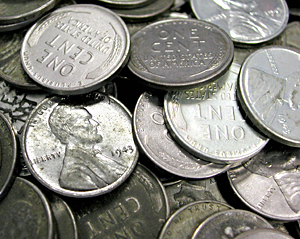Seen Any 1943 'Steelies' Lately?
|
"Making Cents"
The Signal
Saturday, February 25, 2006
| T |
The first theory, which has support in some arenas, is that they were hoarded. In support of this theory, I bought a bag of such coins just two years ago from an 80-year-old man who put them in a bag back in the 1940s and 1950s. There were more than 3,000 in the bag. Now multiply that by thousands of hoards, and it explains a percentage of the disappearance.
A former bank teller I know, who is now about 85, told me that her bank ordered the tellers to set aside these 1943 cents so they could be returned to the Mint or the Federal Reserve — she wasn't certain, other than the fact that they were withdrawn from further circulation.
An article in the February issue of The Numismatist, the journal of the American Numismatic Association, addressed this matter, and two more stories popped up.
One stated that large quantities of these coins were dumped into the ocean. It did not explain the source of the coins or who did the dumping. The other related to old-time steel workers who reportedly recalled seeing mounds of these coins being tossed into the furnace to be melted into steel ingots. The writer indicated that when some spilled over before being melted, workers scooped them up and hid them in their lunch pails. This was said to have occurred shortly after World War II.
Combining the stories of hoarding, dumping, melting and withdrawing from circulation by banks, one can readily see why, by the 1960s, such coins were rarely found in change.
Over the years, several studies of circulating coinage showed that for their age, the 1943 cents turned up far less often than other coins of the late 1930s or early 1940s.
Several mega-hoards have come to light in recent years, including some of up to 8 million coins. The percentage of 1943 cents in each hoard was minuscule, compared to earlier minted coins.
That does not make 1943 cents scarce or rare. Enough mint-condition coins were hoarded by speculators and collectors that today, you can buy mint-condition rolls of these coins from various coin dealers. And for those few circulated 1943 coins still out there, they tend to be dark, black, rusty or a combination of these characteristics and not worth more than one or two cents each.
In fact, the main reason they fell out of favor so quickly was that they tended to rust, corrode and darken within the year of issue. Also, the shiny ones tended to be mistaken for dimes.
It was obvious to Mint officials that the 1943 cent was a bad idea, and they planned for an alternate source of planchets (coin blanks) for 1944 — which turned out to be recycled munition casings of brass.
Chances are, if you have a family member who grew up during the 1940s, he or she may have stashed away some of these strange-looking 1943 cents. Dig around and see what turns up.
Dr. Sol Taylor of Sherman Oaks is president of the Society of Lincoln Cent Collectors and author of The Standard Guide to the Lincoln Cent. Click here for ordering information.
©2006, THE SIGNAL · ALL RIGHTS RESERVED.
